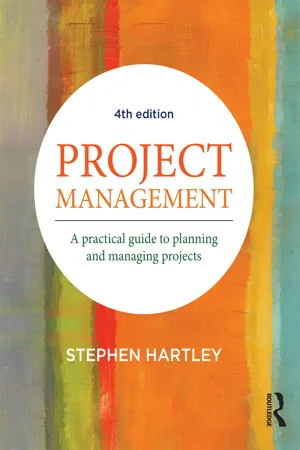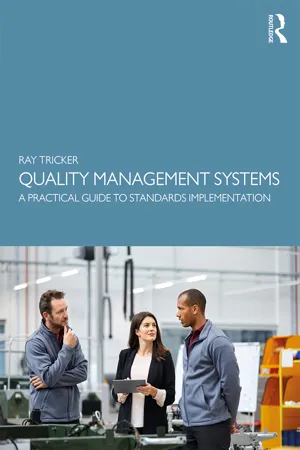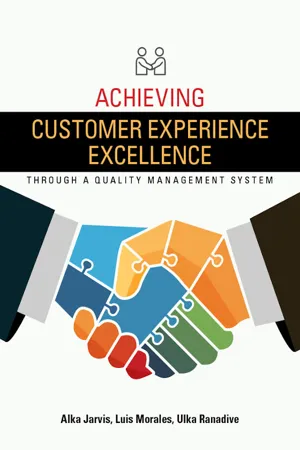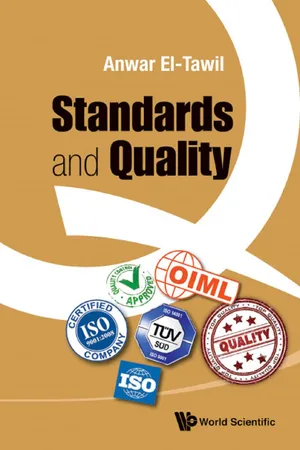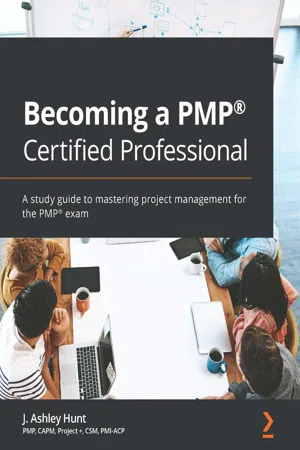Business
Quality Management
Quality management involves the systematic processes and activities that organizations use to ensure that their products or services consistently meet or exceed customer expectations. It encompasses quality planning, control, assurance, and improvement to enhance customer satisfaction and achieve business objectives. By implementing quality management practices, businesses can enhance their reputation, reduce costs, and drive continuous improvement.
Written by Perlego with AI-assistance
Related key terms
8 Key excerpts on "Quality Management"
- eBook - ePub
Project Management
A practical guide to planning and managing projects
- Stephen Hartley(Author)
- 2020(Publication Date)
- Routledge(Publisher)
Chapter 7Quality ManagementAchieving technical excellence and customer satisfactionKey points- ∎ The personal definition of quality
- ∎ Planning for Quality Management
- ∎ International Organization for Standardization (ISO)
- ∎ Demonstrating quality assurance
- ∎ Quality-assurance tools
- ∎ Quality control processes
- ∎ The true costs of quality
- ∎ Embracing continuous improvement
In practiceFor such an objective topic, quality has an incredibly subjective pedigree.So what does quality mean and imply? Is it an agreed standard of work, a specification, a requirement, a business rule, what the finished work looks like or how well some function is performed? And does it relate to only Quality Management systems, to management systems in general or is it the sole domain of project management?Realistically, it could be all of these. Each of these interpretations (or measures) of quality sound as if they are output based. In other words, they each describe the finished product, service or, in our terms, how well the output or outcome (remember that these are two entirely different concepts) of the project complies with some measure—ideally some performance measure (acceptance criteria) or other project objective.But taking a broader perspective, our understanding of quality could, in fact, be extended to include what could be termed 'process-based' criteria for examining quality–in other words, the supporting (business or project) processes through which the agreed quality standards are regularly (and perhaps randomly) monitored, inspected and reported on to ensure compliance is maintained from start to finish.So is it a measure? Is it a process? And does it (whatever it is) enable project organisations to succeed through targeting management responsibility, performance enhancement, employee motivation, customer satisfaction and continual improvement?Chapter overview
PMBOK (2013) defines project Quality Management as the 'processes and activities ... that determine quality policies, objectives and responsibilities', contributing to satisfying the project's objectives. Through a process predicated on continuous improvement, Quality Management ensures that both the project's physical requirements (scope, schedule and cost) and process requirements (documentation) are addressed. - eBook - ePub
- Chris March(Author)
- 2009(Publication Date)
- Routledge(Publisher)
section 8.4 ) referred to in ISO 9001:2000 and ISO 9004:2000, it has become more a management of quality issues which includes people as described below. This is often referred to as Total Quality Management (TQM) described by the Department of Trade and Industry (2005) as:A business philosophy that focuses on quality throughout the organisation. It aims to deliver complete customer satisfaction, benefits to all staff and benefits to society as a whole.8.4 The eight key principles of TQM
The International Organisation for Standardisation publication, Quality Management Principles (2001), states that the eight key principles of TQM are:- customer focus
- leadership
- involvement of people
- process approach
- systems approach to management
- continuous improvement
- factual approach to decision making
- mutually beneficial supplier relationships.
8.4.1 Customer focus
All organisations depend on their customers and therefore should understand their needs, be able to meet their requirements and try to provide a product or service that is better than expected. In reaching this goal, the organisation will find they have become more flexible and speedier in reacting to the market, their own organisation will be better prepared in meeting the customer’s needs and this will result in more business as a result of customer loyalty. Historically, in construction, the industry has not been customer friendly, resorting to a more adversarial approach adhering strictly to the conditions laid down in the contract documents at the expense of everything else. However, in recent years this attitude has changed considerably with the development of new forms of procurement such as partnering and management contracting (Finance and Control for Construction, Chapter 8 ).An organisation focusing on the customer has to research and understand their needs and expectations and ensure this is communicated throughout the organisation. Performance has to be monitored and deficiencies addressed rapidly. This should not be carried out in an ad hoc basis but systematically managed to make it work. However, satisfying customers must be balanced with other interests such as the shareholders, employees, suppliers, financiers, society and the environment. - eBook - ePub
Quality Management Systems
A Practical Guide to Standards Implementation
- Ray Tricker(Author)
- 2019(Publication Date)
- Routledge(Publisher)
These activities include formulating a quality policy, setting quality objectives and establishing Quality Processes. They also include quality planning, Quality Control, Quality Assurance, and quality improvement. (See Figure 1.54) Previously, the overall responsibility for an organisation’s Quality Management System was the sole responsibility of the Quality Manager, who was often referred to as the Management Representative. The new Management System Standards ISO has removed the mandatory requirement for a single person (i.e. a Quality Manager) to be responsible for quality within an organisation. Now, effectively, EVERYONE in the organisation is collectively responsible for the quality of the organisation, its products and its services! Figure 1.54 Typical organisational chart Quality Management ensures that an organisation’s, products and services are consistent. It has four main components: 1 Quality planning – identifying which quality standards are relevant to the product or service and working out how to satisfy their requirements 2 Quality control – ensuring that products and services have achieved their highest standard and that their manufacture, installation, modification and/or repair have been completed in an efficient and timely manner 3 Quality assurance – providing assurance to a customer that the standard of workmanship within a contractor’s premises is of the highest level and that all products and services leaving that particular organisation (or supplied by that organisation) are above a certain fixed minimum level of specification, and 4 Quality improvement – analysis of performance and systematic efforts to improve it. Quality Management is not, however, focussed just on product and service quality but also on the means to achieve it - Alka Jarvis, Luis Morales, Ulka Ranadive(Authors)
- 2016(Publication Date)
- ASQ Quality Press(Publisher)
Quality Management System3.1 IMPORTANCE OF QMS AND RELATED INDUSTRY STANDARDST he buzz about quality is no longer a fad or the latest thing to pursue. Organizations have realized that quality cannot be an afterthought if they want to remain in today’s competitive marketplace. Quality is a carefully planned program with various goals and associated metrics. However, monitoring the results alone is not sufficient. With new products, new technology, and new ideas, the supply of products and services exceeds demand. International trade has enabled businesses to compete globally and increased the need for a new management paradigm with a focus on quality.Martin Luther King said that we are faced with the reality that tomorrow is today and with the urgency that today is now. With this in mind, it is a fact that everyone is motivated to pursue quality, which is not easy to attain due to high-paced business atmospheres and the costs involved. We are in a time of tremendous transition as far as customer satisfaction is concerned. Now the stress is not only on satisfaction but also on customer experience.Quality is more complicated than it appears. It has so many different meanings that before we go any further, let’s define this term that is used so often in various contexts. Looking at hundreds of descriptions, in summary quality means:- Meeting customer requirements by providing defect-free products or services, according to customer specifications
- Addressing current needs, future needs, and experiences of a customer, and delighting the customer
The ability to meet current and future needs includes the economic value of the product or service to the customer and the common…ilities- eBook - ePub
- Bruce Sherring-Lucas(Author)
- 2005(Publication Date)
- Routledge(Publisher)
2 WHAT IS A Quality Management SYSTEM?‘A management system to direct and control an organisation with regard to quality.’ (ISO 9000:2000)Let’s get one thing straight from the start; a company controls its business through the application of a business management system, not as the standard suggests through a quality management system. So don’t get hung up on the word quality.Consider if you will, ISO 9001:2000 sets the standard for a business management system which, if implemented correctly, will lead to products and services of a predetermined quality. These products and services will, in turn, satisfy the customer’s requirements and expectations.A better title for ISO 9001:2000 would possibly be ‘A Standard for Business Management Systems’. Indeed, a number of companies that have implemented ISO 9001:2000 have deliberately avoided using the term ‘quality’, preferring instead to simply call their business activities a ‘management system’.Having said that, for the purposes of this book, we will stick with the term Quality Management System, as it is ill advised to upset the International Standards Organisation!A Quality Management System is the organisational structure of responsibilities, activities, resources and events that together provide procedures and methods of implementation to ensure the capability of an organisation to meet quality requirements.A successful Quality Management System (QMS) relies on a variety of interactions and inputs within an organisation as indicated in Figure 2.1 .Figure 2.1 The ingredients of a Quality Management SystemAn organisation having a carefully structured QMS can achieve their ultimate goals for Quality Assurance (QA) and Quality Control (QC).The first thing that ISO 9001:2000 requires is for an organisation to set up and fully document their position with regard to quality assurance. These documents comprise the QMS and describe the organisation’s capability for supplying products that will comply with laid down quality standards. The Quality Manual contains a general description of the organisation’s quality policy and provides specific details about the quality assurance and quality control within that organisation. - eBook - ePub
- Anwar El-Tawil(Author)
- 2014(Publication Date)
- WSPC(Publisher)
CHAPTER 7QUALITY AND Quality Management SYSTEMS7.1 THE EVOLUTION OF QUALITY CONCEPTSThe growing globalization and liberalization of markets have resulted in increased competition in countries with an open economy. In fact, globalization presents both an opportunity and a challenge to local industries. The opportunity is that those industries have access to the markets of other countries. The challenge is that manufacturers from other countries also have access to their markets. The outcome is that the industries of developing countries, which have been protected for many years by tariffs or quantitative restrictions, are now under unprecedented pressure to become more competitive. This has become a condition for the survival of those industries.Increased competitiveness can be achieved, based on three main factors: quality, price and delivery time of products and services. Other factors that affect competitiveness to a lesser extent are innovation, differentiation and flexibility in satisfying specific customer requirements.At this point, it is important to define exactly what is meant by quality. The international standard ISO 9000 gives the following definition:QUALITY is “the degree to which a set of inherent characteristics of a product or service fulfils requirements”.Since this definition relates quality to the fulfilment of requirements, the standard further explains that requirements can be stated (for example, in a standard or a purchase document), implied (that is, something people normally take for granted) or obligatory, such as in the case where mandatory technical regulations apply. Requirements may include aspects related to:• performance• safety• usability• economics• dependability• aesthetics7.2 THE EVOLUTION OF Quality ManagementIn traditional, pre-industrialized societies, quality was the responsibility of the craftsman. The craftsman was responsible for both the design and realization of the product. When interchangeable mass production was introduced and generalized, specialized inspection departments were created to control the quality of materials, components and final products. This resulted in a separation of the control function from the production function. - eBook - ePub
- Ray Tricker(Author)
- 2016(Publication Date)
- Routledge(Publisher)
‘A Standard for Business Management Systems’, especially as there are so many other management systems directly related to ISO 9001. Indeed, a number of companies that have implemented ISO 9001 have deliberately avoided using the term ‘quality’, preferring instead to simply call their business activities a ‘management system’.Following recent international agreement, however, that in future all management system standards shall have the same high-level structure, identical core text, as well as common terms and definitions, this means that business management is paramount and perhaps Quality Management will become more of a subset to the former.Having said that, for the purposes of this book, we will stick with the term Quality Management System, as it is ill advised to upset the International Standards Organization at this stage!So what is meant by a successful Quality Management System (QMS)? To be effective, an organisation relies on a variety of interactions and inputs (as indicated below) in order to achieve their ultimate goals for Quality Assurance (QA) and Quality Control (QC).FIG. 2.1 The ingredients of a successful Quality Management SystemTogether, these documents comprise the organisation’s Quality Management System and describe their capability for supplying products and services that will comply with laid-down quality and other regulatory standards.Previously this was contained in the ‘Quality Manual’, which was a document setting out the quality policies, systems and practices of an organisation’s Quality Management System.With the introduction of ISO 9001:2015, the International Standards Organization (ISO) Committee responsible for updating the standard also created a standard format (i.e. Annex SL – see Chapter 5 .5) with the same high-level structure, identical core text and common terms and definitions – but they left out - eBook - ePub
Becoming a PMP® Certified Professional
A study guide to mastering project management for the PMP® exam
- J. Ashley Hunt(Author)
- 2021(Publication Date)
- Packt Publishing(Publisher)
Chapter 9 : Quality Management In this chapter, you will review the knowledge area of Quality Management. You will begin with an overview of the entire Quality Management knowledge area and the Quality Management plan, which describes how to manage and control your quality. Then we will review the best practices to audit your quality process and inspect your results for defects. The following topics are covered in this chapter: Key concepts for Quality Management Trends and emerging best practices Tailoring considerations Considerations for Agile/adaptive environments Planning for Quality Management The Manage Quality process The Control Quality process Key concepts for Quality Management The goal of any project is to complete the deliverables as stated by the requirements and to make sure that they function the way they are supposed to. If your result is a bicycle, it could meet all the scope requirements and be the best-looking bicycle on the road. However, if the chain falls off and the brakes don't work, then it's just a large sculpture; isn't it? Failure to meet quality requirements can have serious negative consequences for any or all of the project stakeholders. According to the International Organization for Standardization (ISO 9000 series), the definition of quality is "the degree to which a set of inherent characteristics fulfill requirements." The project manager and team's job is to determine which requirements for both quality and grade are necessary. Quality versus grade Grade is a category assigned to products or services having the same functional use but different technical characteristics. Let's look at this in two different ways. A prime example is when you go to the gas station to fill up your car. You have choices in grades of gasoline: low grade, middle grade, and high grade. The higher-grade gasoline is not only more expensive, but it has other agents in it that make it a higher grade
Index pages curate the most relevant extracts from our library of academic textbooks. They’ve been created using an in-house natural language model (NLM), each adding context and meaning to key research topics.
